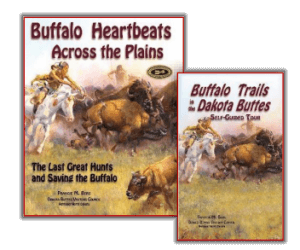What does 4-H stand for? Head, Heart, Hands and Health!
Today nearly six million children and teens are learning important values through the 4-H program. But how did 4-H find its humble beginnings?
The 4-H program began in the late 1800s when researchers learned adults in the farming industry did not readily accept new developments but also learned young people would accept those new ideas, according to the 4-H.org history page.
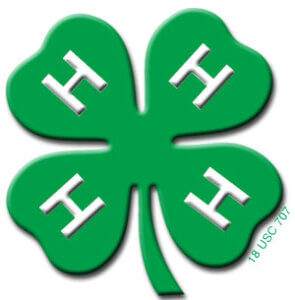
The 4-leaf clover is simplicity itself: Head, Heart, Hands and Health—since 1910!
In 1902 A. B. Graham started the first youth program in Clark County, Ohio, called “The Tomato Club” or the “Corn Growing Club.”
It seems others had the same idea about the same time, as T. A. Erickson, Douglas County, Minnesota started an agricultural after-school club.
Jessie Field Shambaugh developed a clover pin with the 4-H on each leaf in 1910. By 1912 they were called 4-H clubs.
1914 saw the Smith-Lever Act passed, which helped the US Department of Agriculture create the Cooperative Extension System. Extension offices combined the knowledge and resources of federal, state and local governments to meet the needs of educational programs through 4-H.
Today, in the US 4‑H serves youth in rural, urban and suburban communities in every state across the nation. 4‑H’ers are tackling the nation’s top issues. Projects range from cooking to cattle, from entomology to electricity, archery to art and from sewing to skateboarding.
4‑H out-of-school programming, in-school enrichment programs, clubs and camps also offer a wide variety of STEM opportunities—from agricultural and animal sciences to rocketry, robotics, environmental protection and computer science—to improve the nation’s ability to compete in key scientific fields and take on the leading challenges of the 21st century. There are so many excellent opportunities in 4-H to improve life for your children.
4-H members gain confidence through practicing skills like public speaking, presentation, demonstrations and expressing a point of view as club members during meetings.
Also exciting social events such as 4-H Fair, 4-H Camp, Congress and more. They learn to be organized, problem solvers and volunteers through local, state and national leadership positions on 4-H Council, 4-H Foundation and 4-H Youth Council.
Each member enrolls in projects of their own choice to learn more about topics of interest to them. They can even design their own projects if they choose.
A Buffalo Rancher-Leader
With a long list of over 200 4-H projects available, why not include BUFFALO—our magnificent NATIONAL MAMMAL? YES!
If you’re a 4-H Leader or parent maybe you have a 4-H member or two who would love to take an “Exotic Animal” project. Why not encourage them to learn about Buffalo, as the species is commonly known?
Even though Buffalo have lived in North America since before the last ice age, there’s much of interest to learn about our magnificent new National Mammal.
4-Hers can design their own program even without owning a bison themselves. They can study, each at their own level, other aspects of buffalo—for example, their history, their long and unique cultural relationship with Native American peoples, how buffalo were saved from extinction, their social order, or how to handle a herd.
Or they might “purchase” an animal from a neighboring herd, either in reality or by figuring out realistic costs and conditions on paper. They can write and exhibit that report at the county level and even state fair.
A rancher with a buffalo herd is a potential 4-H club leader. If you have such a person in your community, why not see if you can interest him or her with being a buffalo project leader?
Or if you own or are familiar with buffalo maybe you will enjoy the challenge of sharing your knowledge with young people?
Yes, its true—4-H Project books that include Buffalo are rare!
Research on Buffalo is rare as well. But that could change, now that we have in the US a Center of Excellence for Buffalo Studies, as of Sept 2020. It’s headquartered at South Dakota State University’s West River Research and Extension facility in Rapid City, SD.
Teaching about our National Mammal can be an enlightening and fun experience for the entire 4-H Club!
One Girl’s 4-H Bison Experience
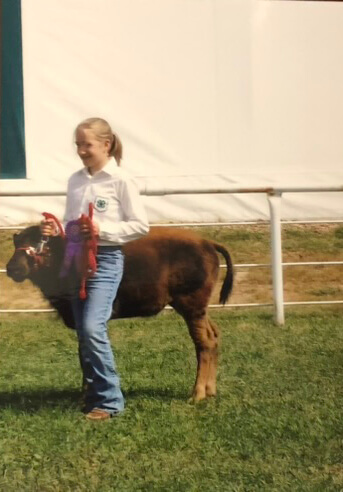
Ashley McFarland showed her Buffalo calf at age 12, at our County Fair in Hettinger, ND. She lives just south a few miles into SD. Photo submitted by Roxann McFarland.
Ashley McFarland, a 4-H girl in our community developed her own Buffalo Project when she was only 12! And became a 5th generation Buffalo rancher!
Ashley’s great-great-grandfather, Frank McFarland, came to South Dakota and homesteaded near the North Grand River in 1909. He began to hear about buffalo for sale in the Black Hills State Park and got the idea he’d like to start a buffalo herd.
But first he had to raise a family, build a beef herd and survive the desperately dry years of the 1920s and 1930s. Then, in 1959, he and his son Roy bought four buffalo, according to “Wind and Waving Grass,” the history of Northwest Perkins County, Lodgepole Community.
They ran them with their beef cattle for awhile. But by 1974 the family had a stable buffalo herd and their 3rd Production sale of buffalo calves and meat.
Ashley grew up on the family homestead with buffalo, her younger brother Paden, Dad Steve, Mom Roxann and Grandpa Eugene and Grandma Verna.
One spring a buffalo cow in the family herd birthed twins and as often happens on the buffalo range, the mother claimed only one.
Steve found the extra little tyke lying alone in the pasture and brought her home for a bottle of colostrum.
Dad, Steve McFarland expertly feeds a bottle of colostrum—rich in nutrients and protective antibodies– to a skeptical buffalo calf.
Ashley named her calf ‘Sienna’ and took over the bottle feedings.
They bonded and soon Ashley had a halter on her buffalo and could lead her anywhere.
In August Ashley brought her well-behaved little calf to show at our County fair in Hettinger, ND. At four months Sienna was still the bright red-gold color of young buffalo calves, but turning dark.
She entered her exhibit under the category ‘Exotic Breed’ and won a purple ribbon. Awarded the best (and only one) in her class.
Ashley’s advice to other 4-Hers who want to show a buffalo calf?
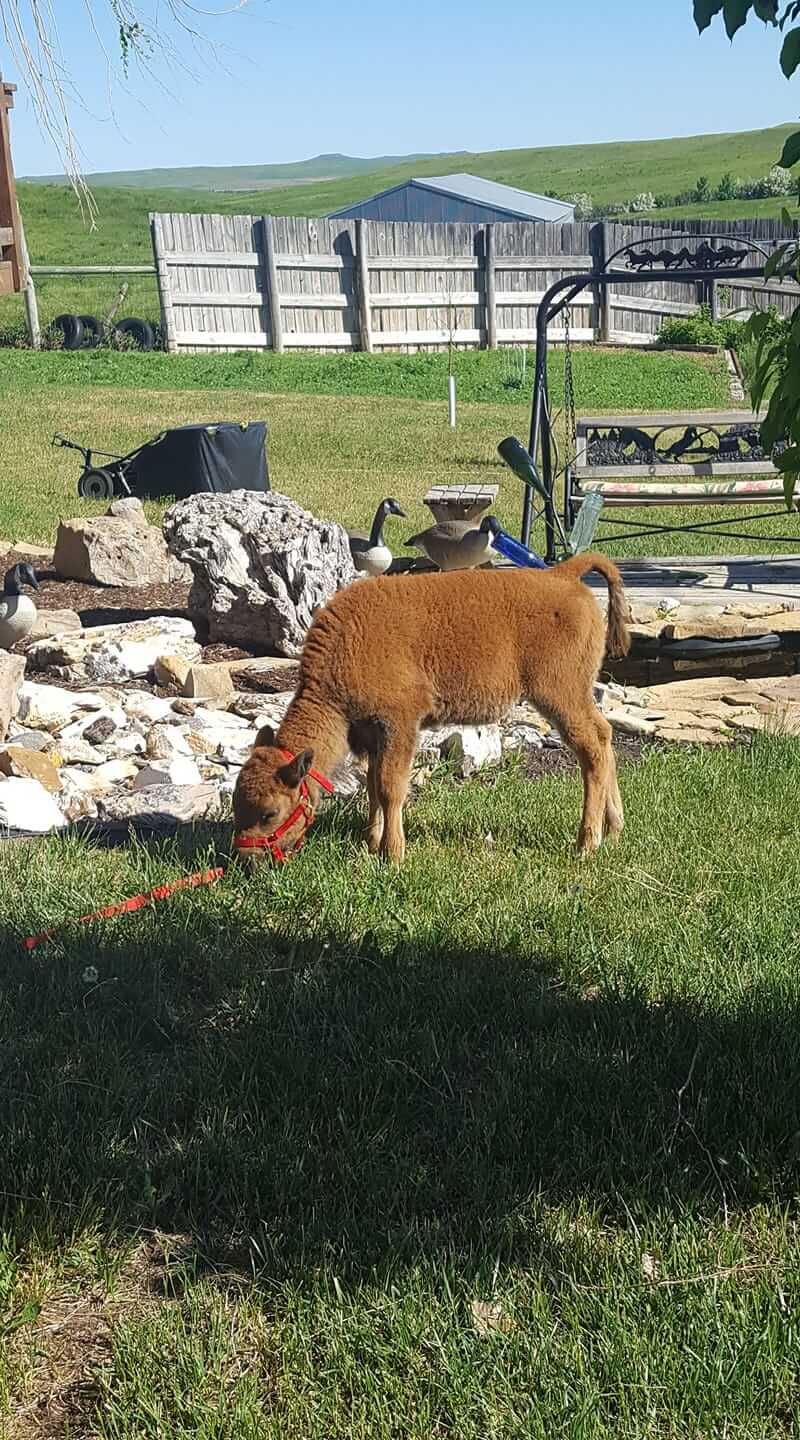
If you’re showing, Ashley McFarland advises, “You have to spend time with your calf. Work with it and teach it to be calm with a halter on.” Photo courtesy of Donna Keller.
“You have to spend time with your calf,” she says. “Work with it and teach it to be calm with a halter on.”
Remember all those possessive mother buffalo?! We can imagine a big shaggy mother being all too willing and able to run off a small girl or boy who tries to interfere with her calf!
So If you hope to show a buffalo calf, its probably pretty important, as well, that you have an orphan calf available, as Ashley did—at the age of 12!!
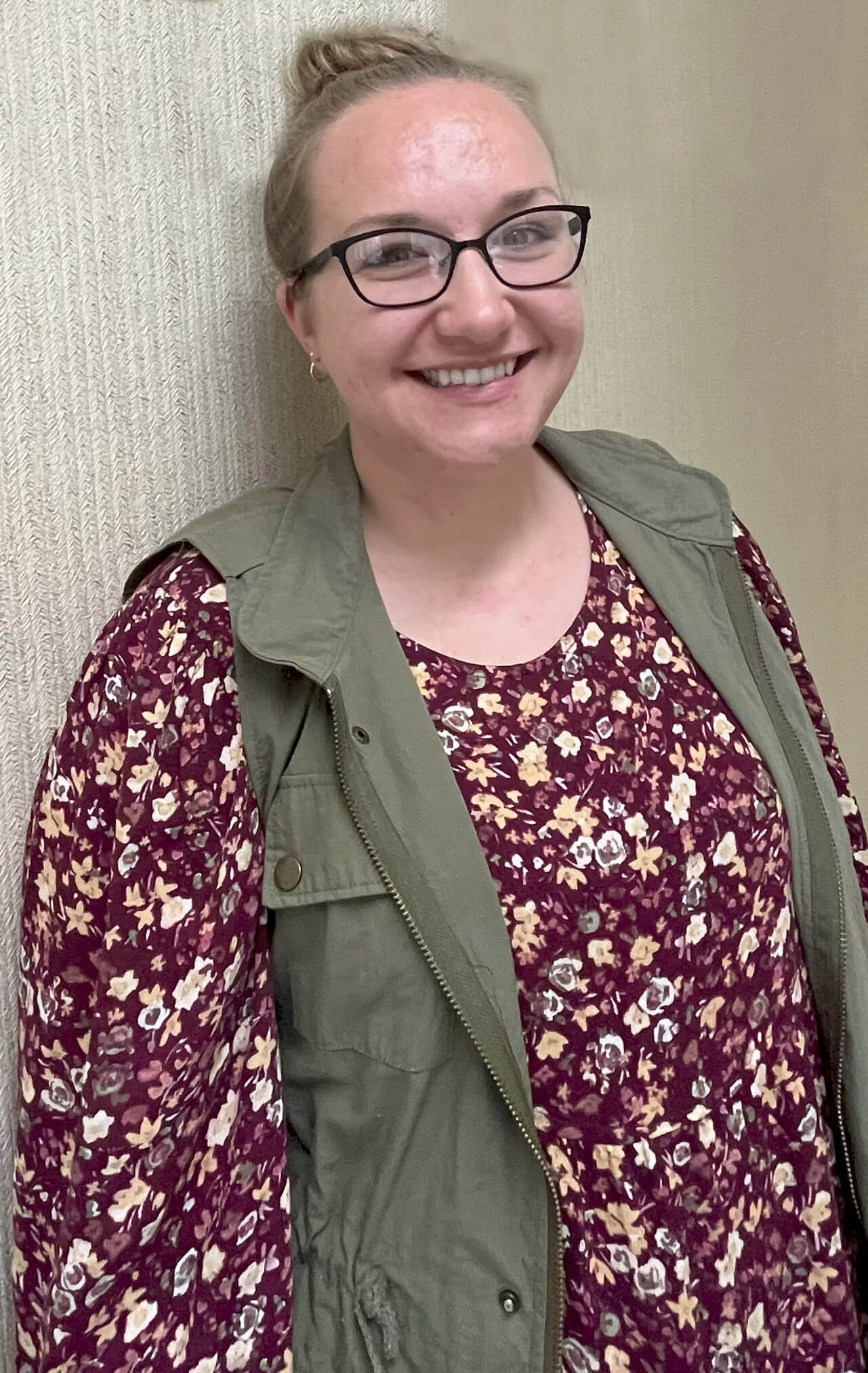
Today Ashley McFarland is still working in Agriculture at the Adams County Farm Service Office in Hettinger.
Steve McFarland has been active in the Dakota Territory Buffalo Association since it was started in 1996—deep in the heart of buffalo country—by a group of buffalo producers from a 12-state area and two Canadian provinces.
His family has shown buffalo most every year at the DTBA Show and Sale in Rapid City, SD where they won Gold, Silver and Bronze trophies, and two years ago the High Selling Bull Calf. They have also showed at the Gold Trophy Denver Show.
4-Hers Sharpen Communication Skills.
4-H members have many opportunities to present to a group and interview one on one with an adult throughout the 4-H year. These experiences allow them to develop above-average confidence and skill in communicating with both peers and adults, in both prepared and spontaneous settings.
4-H brings youth together with caring adults and peers, both face to face and virtually, to ensure belonging and a connection to their community. Youth who are connected to their community are less likely to suffer from severe depression or attempt suicide.
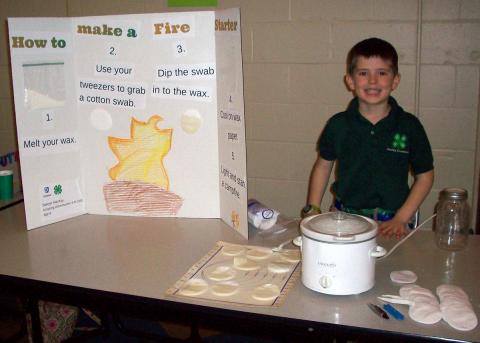
The success that young 4-Hers feel in presenting a skill to their friends helps them build confidence in how to communicate. Older members help, so everyone has a chance to shine!
Best of all they learn to communicate and listen—and “Learning by Doing!” An easy way to learn.
One interesting facet is that 4-Hers of every age help each other—older members help the younger ones. So everyone has a good chance to shine.
That’s very different from sports and school competitions in which young people compete every day with youngsters their own age. In 4-H they likely have even more leadership opportunities.
4-H offers a network of caring peers for young people to reach out to during challenging times.
4-H is a community that allows for building trust and relationships that are not always replicated in other areas of a member’s life. These relationships are built on common interests and are strengthened by the bond of belonging and inclusion.
A recent study indicated that participation in 4-H programming during the COVID-19 Pandemic contributed to keeping communities connected during times of isolation.
This might have been a virtual club meeting, 4-H project work to keep kids engaged, a call from a 4-H volunteer, or an organized service project done at home. 4-H’ers helped themselves, their friends and their community during challenging times.
4-H Promotes Positive Citizenship
4‑H programs empower young people to be well-informed citizens who actively engage in their communities and the world. Youth become involved in their community, build decision-making skills, develop a greater sense of understanding and increase their confidence in connecting to others.
4‑H members contribute hundreds of thousands of hours back to their community every year. In Montana over half of 3rd through 6th grade 4-H members indicated they had more opportunity to help plan a community service project since joining 4-H, while 24% reported having led a community service project as a member of 4-H.
Since I grew up with 4-H in Montana, worked as a County Extension Agent there, was an IFYE, 4-H Leader and am a huge supporter of 4-H for life, I’m enjoying sharing this Montana report with you. (italic) (FMBerg)
Citizenship and community connection are especially impactful in underserved communities, including Montana’s reservations. (14% of 4-H youth served in 2019-2020 identify as Native American. This is double the average participation level statewide.
42% are more aware of important needs in their community after joining 4-H. Over one-third of 7-12th grade 4-H youth report being likely to talk to their friends about issues affecting their community, state or world. (Ital) Survey Data from Montana 4-H Citizenship Impact Survey 2019.
Quotes from Montana 4-Hers and Parents
“4-H has helped me grow up and be a person who can be confident and well-spoken in a group setting. I can relate to younger 4-H members to help them grow in their projects by using the experience I have had with my own projects. [Because of 4-H] I have also had several successful job interviews.” (ital) Hill County 4-H’er age 17
“I have participated in multiple presentations, from one person in the audience to hundreds. If I had not done 4-H I would not have had these opportunities to develop my speaking and listening skills.” (ital) Gallatin County 4-H’er age 13
“The communication skills my children have gained in 4-H is one of the great benefits that they received from their participation. As they attend college classes, they are amazed at how easy it is for them to complete public speaking assignments and what a difficult time other students have had.” (ital) Parent of Carbon County 4-H Alumni
“Because of 4-H my children have gained the confidence and experiences from the structured and non-threatening environment to excel in most speaking situations.” (ital) Parent of Richland County 4-H members
Alberta 4-H Bison Program
Not many 4-Hers take Bison as a project. I think that’s only because they haven’t thought about how it can work!
My congratulations to Leila Milne and the Province of Alberta, Canada, for creating their unique Alberta Bison 4-H project! Developed in 2002-2003.
It’s the only one I’ve ever seen in either the US or Canada! Surely one of a kind!
It is a truly unique livestock project that allows you, as a member, the opportunity to learn about the role that bison played in our history and the value they will continue to have in the new millennium.
Note that the Bison 4-H project does not follow the traditional 4-H livestock rules! As they say, “It can’t be rode, and it can’t be showed!” Well, not usually!
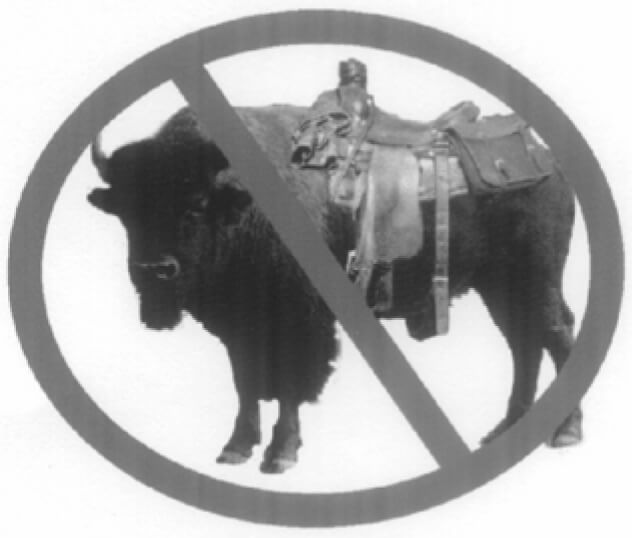
It can’t be rode.
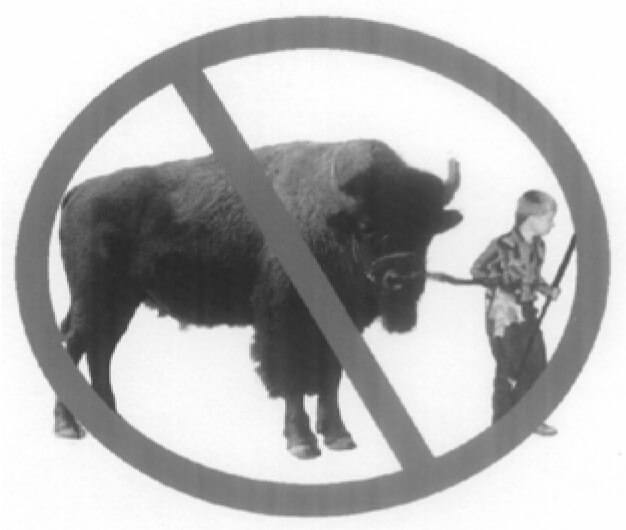
It can’t be showed!
It’s a great start pioneered in one Canadian Province–Alberta. The third year of their 4-H Bison project, gives a lot of food for thought—and includes this suggestion:
“Your challenge, as you work through this project year is to answer the question:
What is the ‘Bison Advantage!’
“Explain what you believe to be the most important points of the bison advantage and why? Remember, everyone has their own beliefs about what the bison advantage is.
“Actually, this is a question that is nearly impossible to answer!! However, one thing that all people in the Bison industry do completely agree on is the fact that a Bison advantage really does exist. Are you confused?
“Let’s try to make sense of this. The Bison advantage is all the benefits people gain from bison. This affects everyone from producer to consumer and all those in between.”
Don’t try to learn everything all at once! To the Alberta 4-Her, Bison becomes a very flexible program.
There’s a great list of contents at each of the 3 levels. At first it seems as if the 4-Hers are expected to look up all that information from buffalo sources on their own.
But as they begin at the first level—the first year— they will want to be selective. Which topic or topics to focus on? Who will help—older members? Adult leaders? The Alberta Bison Association? Maybe all of the above.
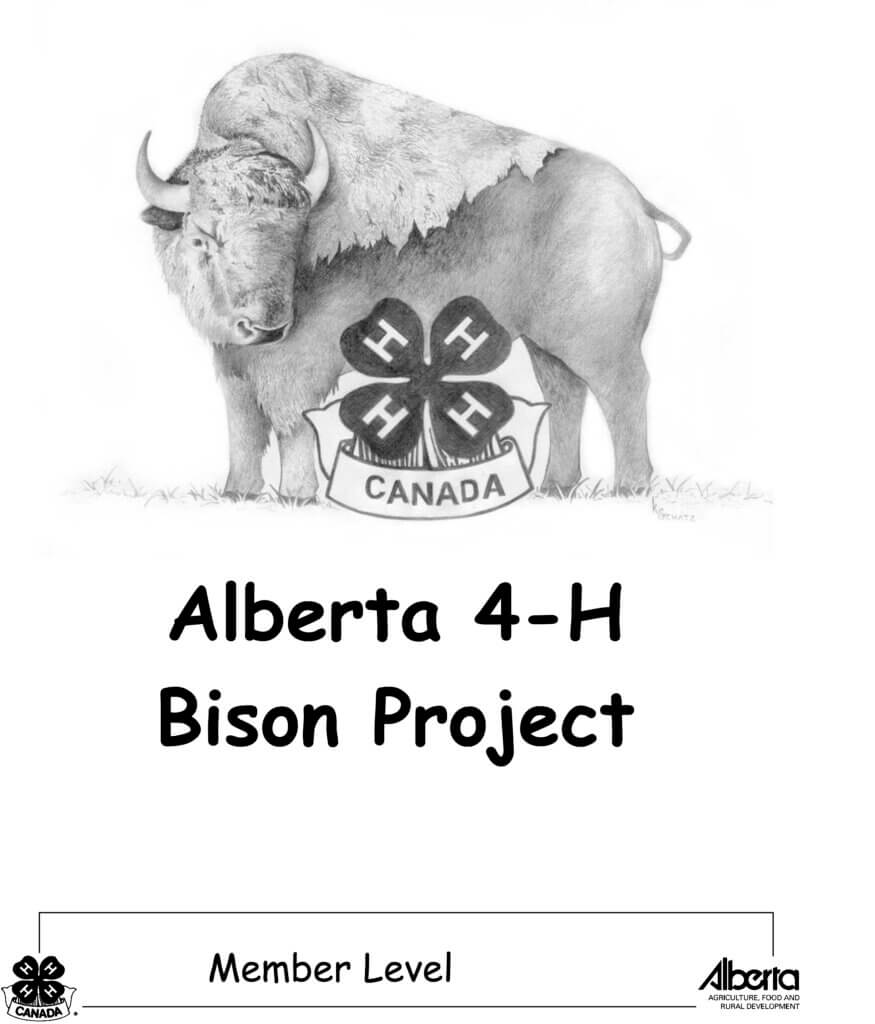
The cover of Alberta 4-H Bison handbook, designed in 2002. One of a kind in a world full of 4-H projects!
In Part 2 of this Blog we’ll bring you more about this amazing Alberta 4-H Program.
Thanks Canada, for your leadership in suggesting many ways 4-Hers can shape their own exciting Bison project!!
Ashley did it! You can too!
_____________________________________________________________________
NEXT: Part 2 – 4-H Bison Project Alberta

Francie M Berg
Author of the Buffalo Tales &Trails blog



